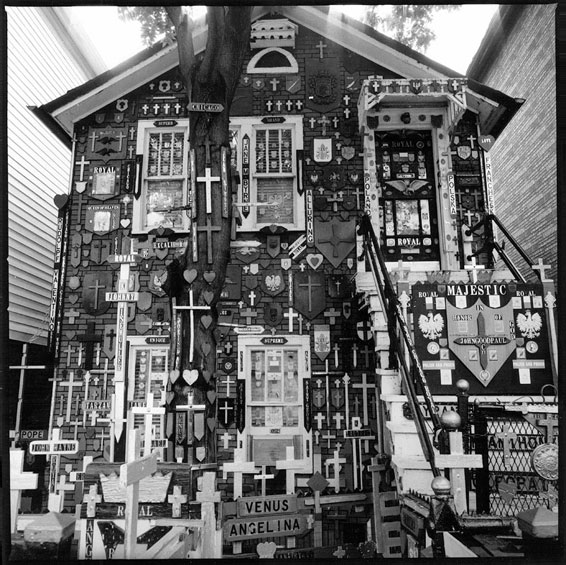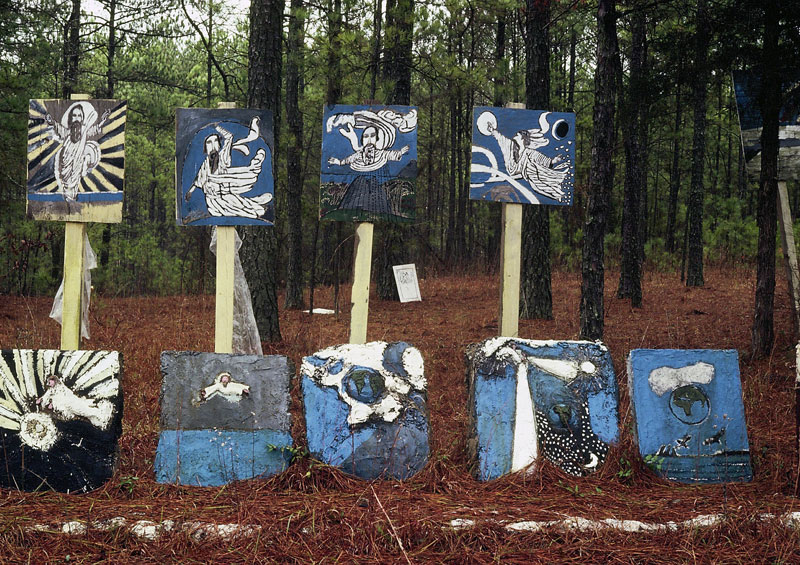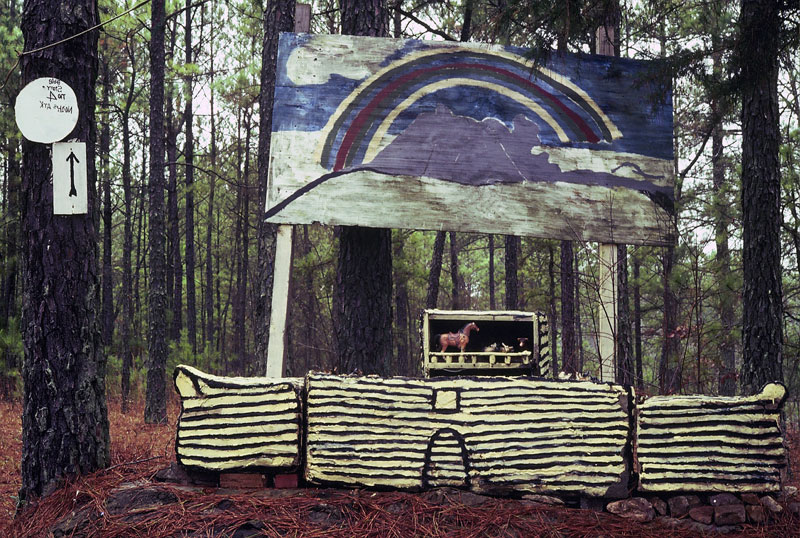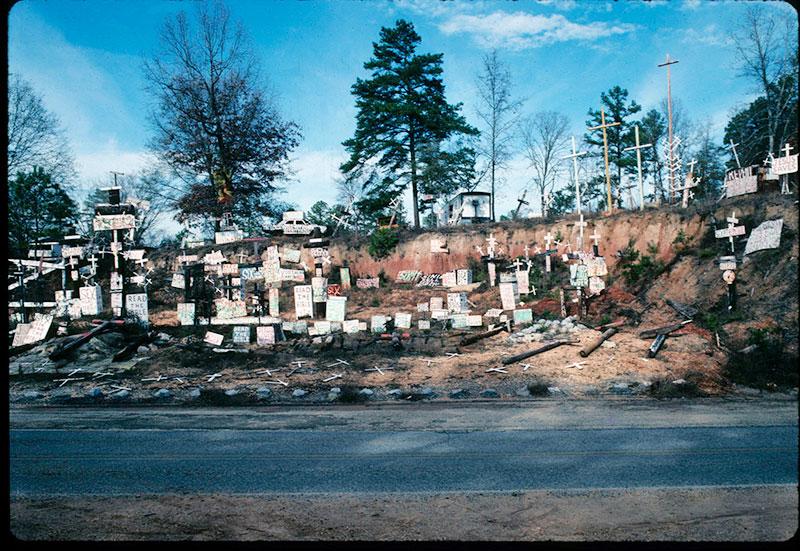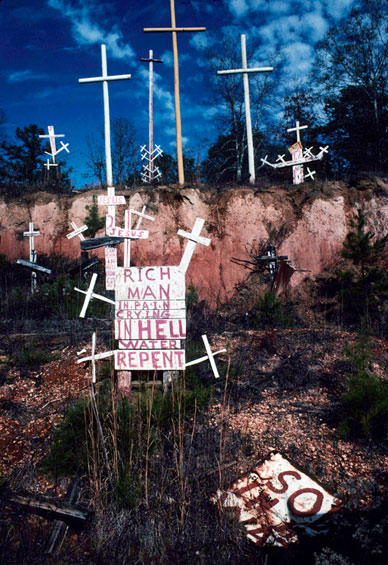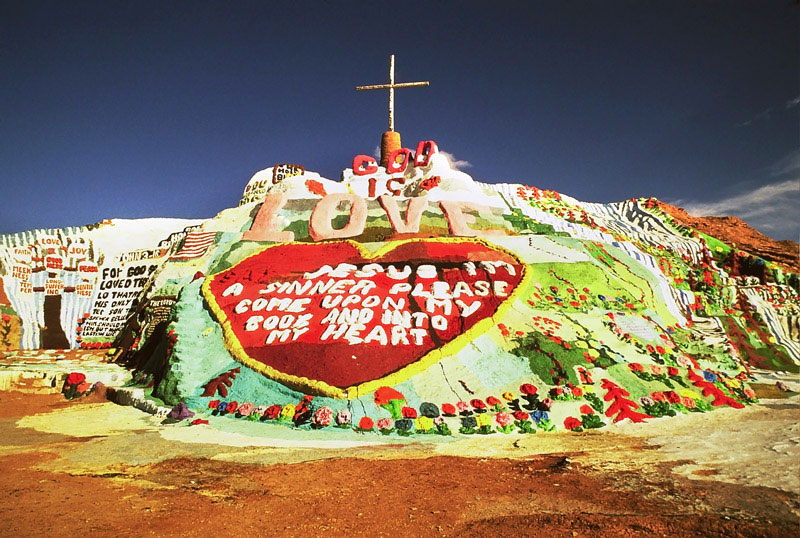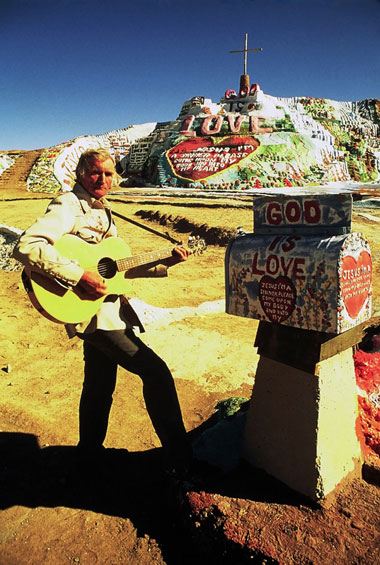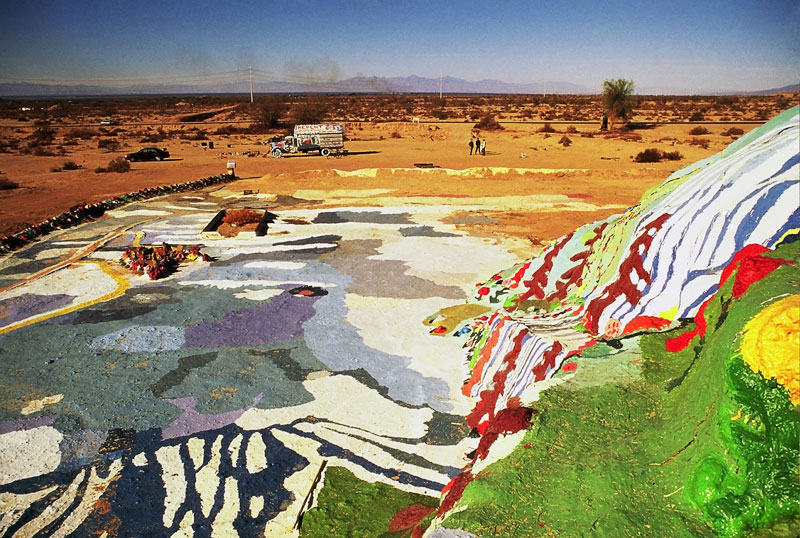
close
 In July of 1989, we stopped at Chris’s Shoe Service, 579 N. Limestone, in Springfield, Ohio, because the building was, appropriately, shoe-shaped. The exterior was painted a shiny, patent-leathery brown and I could see “eyelet” holes along the vamp, which had once held neon laces.
In July of 1989, we stopped at Chris’s Shoe Service, 579 N. Limestone, in Springfield, Ohio, because the building was, appropriately, shoe-shaped. The exterior was painted a shiny, patent-leathery brown and I could see “eyelet” holes along the vamp, which had once held neon laces.
Inside, we met Chris Patsiavos, then in his eighties. His told us father had been a shoemaker in “the old country” (Greece) but his children had pursued other vocations. He built his shoe building in 1953, he said, after he moved out of a shop in the National Bank Building downtown. He showed us a photo of the old store and also a framed portrait of himself at age 21, shirtless and buff. Bob then asked if he could photograph him, and the resulting black and white Polaroid of Mr. Patsiavos entered the travel journal, above an image of his shoe shop.
A 2011 Googlemaps search revealed an empty lot where Chris’s Shoe Service once stood.
Inside, we met Chris Patsiavos, then in his eighties. His told us father had been a shoemaker in “the old country” (Greece) but his children had pursued other vocations. He built his shoe building in 1953, he said, after he moved out of a shop in the National Bank Building downtown. He showed us a photo of the old store and also a framed portrait of himself at age 21, shirtless and buff. Bob then asked if he could photograph him, and the resulting black and white Polaroid of Mr. Patsiavos entered the travel journal, above an image of his shoe shop.
A 2011 Googlemaps search revealed an empty lot where Chris’s Shoe Service once stood.
close
 I had KGAA’s directions to guide us the Jubilee Rock Garden, built by dairy farmer Bill Notzke over several decades, starting in the early 1930s. By the summer of 1989, when we traveled to Brimfield, Illinois, Notzke was no longer living, but his massive concrete fences, terraces, and a memorial archway made to honor his late wife, had been maintained on the property. Notzke’s heirs rented the farmhouse to another family, including a young boy named Jonathan, who introduced us to his dog, Rusty. Notzke’s creations—encrusted with rose and white quartz, geodes, and mica he’d collected in other states to cover his constructions—glittered in the mid-day sun, and I wondered how Jonathan would later recall the years he spent living in this setting.
I had KGAA’s directions to guide us the Jubilee Rock Garden, built by dairy farmer Bill Notzke over several decades, starting in the early 1930s. By the summer of 1989, when we traveled to Brimfield, Illinois, Notzke was no longer living, but his massive concrete fences, terraces, and a memorial archway made to honor his late wife, had been maintained on the property. Notzke’s heirs rented the farmhouse to another family, including a young boy named Jonathan, who introduced us to his dog, Rusty. Notzke’s creations—encrusted with rose and white quartz, geodes, and mica he’d collected in other states to cover his constructions—glittered in the mid-day sun, and I wondered how Jonathan would later recall the years he spent living in this setting.
close
 The winter day we arrived was overcast and drizzly. We introduced ourselves to John Ruth and his wife, Leona, and received their permission to document his version of “the greatest stories in the universe.”
The winter day we arrived was overcast and drizzly. We introduced ourselves to John Ruth and his wife, Leona, and received their permission to document his version of “the greatest stories in the universe.”
Ruth had created a series of numbered displays, including painted concrete tableaux, cement and cloth-wrapped sculptures of animals, and many hand-lettered signs. Shown here are Ruth’s interpretation of Noah’s Ark and one of two versions he made of the creation of the world. This was the “flat version,” which he created because people used to believe the world was flat.
After taking notes and photographing for a while, our clothes were damp, and Leona invited us inside to get warm. Her husband explained some of the site’s history (built on donated land in 1954) and spoke vividly about the deep faith and dream life that inspired his work.
His art environment was not to endure without him. When John Ruth died in 1995, the Bible Garden was destroyed.
Ruth had created a series of numbered displays, including painted concrete tableaux, cement and cloth-wrapped sculptures of animals, and many hand-lettered signs. Shown here are Ruth’s interpretation of Noah’s Ark and one of two versions he made of the creation of the world. This was the “flat version,” which he created because people used to believe the world was flat.
After taking notes and photographing for a while, our clothes were damp, and Leona invited us inside to get warm. Her husband explained some of the site’s history (built on donated land in 1954) and spoke vividly about the deep faith and dream life that inspired his work.
His art environment was not to endure without him. When John Ruth died in 1995, the Bible Garden was destroyed.
close
 His signs had been painted on every large and wasted surface he could scavenge—wrecked cars, abandoned refrigerators—and their placement, just after the bend in a curving road, made the site all the more startling when one suddenly came upon it.
His signs had been painted on every large and wasted surface he could scavenge—wrecked cars, abandoned refrigerators—and their placement, just after the bend in a curving road, made the site all the more startling when one suddenly came upon it.
We spoke with Rice at length inside his small, roadside chapel. I was surprised, at first, by his gentleness. He said he didn’t see himself as a preacher. He wasn’t a learned man who could go up on the pulpit. His art environment and his chapel allowed him to meet with visitors, to pray with believers, and to hand out literature about “God’s plan.” He did not question our beliefs and did not repeat any of the messages his signs articulated so clearly.
We spoke with Rice at length inside his small, roadside chapel. I was surprised, at first, by his gentleness. He said he didn’t see himself as a preacher. He wasn’t a learned man who could go up on the pulpit. His art environment and his chapel allowed him to meet with visitors, to pray with believers, and to hand out literature about “God’s plan.” He did not question our beliefs and did not repeat any of the messages his signs articulated so clearly.
close
 Supporters rallied. Letters made their way to the county supervisors from such places as London and New York, and (more important) from Niland, the town closest to the abandoned military base where Salvation Mountain stands. Knight produced an independent soil test to refute the official’s charges. The county backed down.
Supporters rallied. Letters made their way to the county supervisors from such places as London and New York, and (more important) from Niland, the town closest to the abandoned military base where Salvation Mountain stands. Knight produced an independent soil test to refute the official’s charges. The county backed down.
In January 1997 I finally made my way to Niland, traveling again with Bob. It had been unusually cold and windy in southern California that winter. We drove from San Diego, heading toward Imperial County through miles of unmodulated terrain, then drove through the few blocks through Niland’s center. Around a bend, and we were there.
The midday sun had turned Salvation Mountain’s white and pale-blue rivers silver. I could imagine on summer days it might hurt the eyes to look at this place, a dazzling cutout against a deep-blue, cloudless sky and dun-colored earth.
We recognized Knight from news photos. He wheeled around from the side of his decorated truck and dashed toward our car to greet us. Within minutes we were defying the wind and climbing to the top of the thickly-painted Mountain, occasionally stepping on pockets where the paint below remained liquid. Reaching the top, we tried to shout conversation to each other, but soon gave in to the wind.
In mid-December 2011, 80-year-old Leonard Knight left Salvation Mountain for a fulltime care facility near San Diego. He had worked for over 25 years on his magnificent creation, often in blazing temperatures and biting wind. Now it was time to rest. His good friend Kevin Eubank helped Knight make the move, and those who care about the Mountain and its creator were confident that this comparatively young man would continue to do right by both.
But then Kevin Eubank died unexpectedly. Friends of Eubank and Knight rallied, and soon a group was guarding the Mountain day and night to prevent vandalism and theft. They organized a moving memorial service for Eubank. As of early January 2012, supporters are working to figure out how to preserve Salvation Mountain.
In January 1997 I finally made my way to Niland, traveling again with Bob. It had been unusually cold and windy in southern California that winter. We drove from San Diego, heading toward Imperial County through miles of unmodulated terrain, then drove through the few blocks through Niland’s center. Around a bend, and we were there.
The midday sun had turned Salvation Mountain’s white and pale-blue rivers silver. I could imagine on summer days it might hurt the eyes to look at this place, a dazzling cutout against a deep-blue, cloudless sky and dun-colored earth.
We recognized Knight from news photos. He wheeled around from the side of his decorated truck and dashed toward our car to greet us. Within minutes we were defying the wind and climbing to the top of the thickly-painted Mountain, occasionally stepping on pockets where the paint below remained liquid. Reaching the top, we tried to shout conversation to each other, but soon gave in to the wind.
In mid-December 2011, 80-year-old Leonard Knight left Salvation Mountain for a fulltime care facility near San Diego. He had worked for over 25 years on his magnificent creation, often in blazing temperatures and biting wind. Now it was time to rest. His good friend Kevin Eubank helped Knight make the move, and those who care about the Mountain and its creator were confident that this comparatively young man would continue to do right by both.
But then Kevin Eubank died unexpectedly. Friends of Eubank and Knight rallied, and soon a group was guarding the Mountain day and night to prevent vandalism and theft. They organized a moving memorial service for Eubank. As of early January 2012, supporters are working to figure out how to preserve Salvation Mountain.



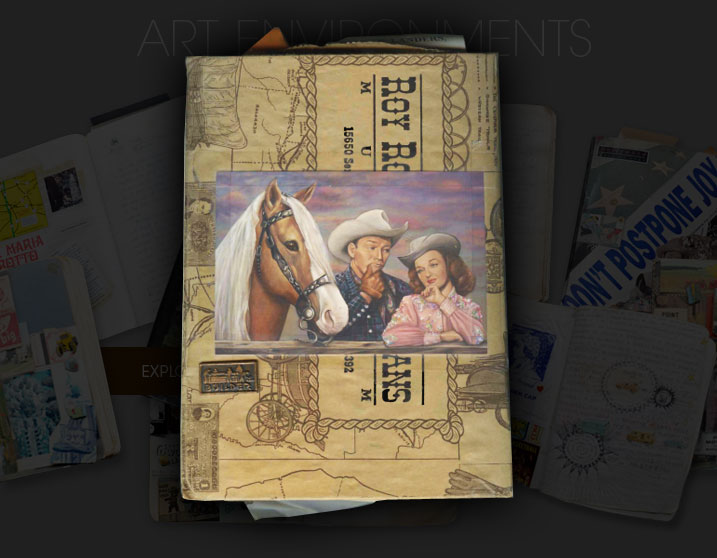
And then we were ready to take to the road, to follow KGAA’s tips and documentation. Over a period of eight years or so we took trips across and around the United States, traveling for as long as our savings held out. I roughly divided the country into regions. Before each trip I would prepare lists of art environments; tips on possible sites from KGAA members, friends, and newspaper articles; roadside attractions (mentioned in books and sometimes in AAA’s state hotel guides); shaped buildings and vernacular architecture (lots of associations for these); old highway neon signs (ditto); diners; boarding houses and old hotels that served home-cooked meals (especially in the southern states.)
I kept travel notebooks for each trip, detailing our findings. Mostly plain black and white ruled journals to start, they were soon stuffed with snapshots and all manner of advertising, matchbook covers, napkins, and other junk (“ephemera”) picked up along the way. A selection follows, enhanced by some of the fine black and white prints and color slide images Robert Foster developed when we returned to New Jersey.
Explore the travel journals
I kept travel notebooks for each trip, detailing our findings. Mostly plain black and white ruled journals to start, they were soon stuffed with snapshots and all manner of advertising, matchbook covers, napkins, and other junk (“ephemera”) picked up along the way. A selection follows, enhanced by some of the fine black and white prints and color slide images Robert Foster developed when we returned to New Jersey.
Explore the travel journals
The KGAA, the reporter explained, was determined to document and to encourage the preservation of large-scale sculptural and architectural creations made by self-taught artists—the kind of extraordinary creations I had come across, by accident, on road trips: the handmade carnival made out of discards, yards filled with cement animals, The Last Supper sculpted out of sand. Now I learned the KGAA had located a considerable number of “grassroots art” environments in the Mid-west, and had amassed “tips” on potential sites, and well-known constructions, worldwide.
I learned they had nearly nothing on New Jersey and joined up with photographer Robert Foster to remedy that deficit. After several years of onsite and archival research, we documented twelve grassroots art sites in the Garden State.


